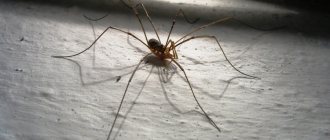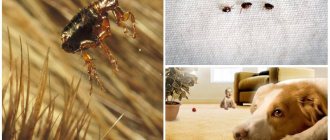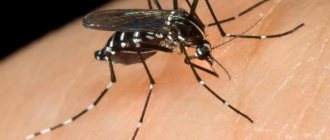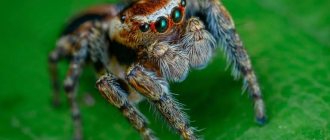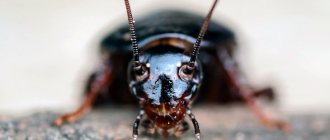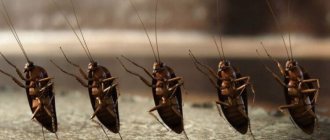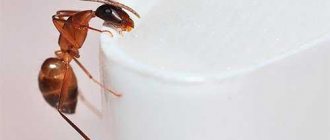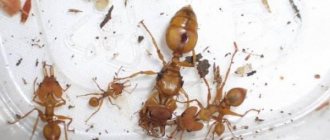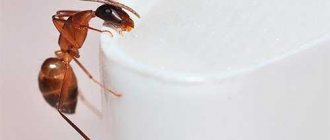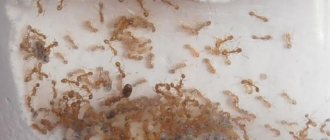Diet in the natural environment
Spiders are obligate predators. The main diet of arthropods includes insects and vertebrates. Specific preferences depend on the subspecies. Experts in this field mention only one vegetarian - Bagheera kiplingi.
Individuals of this subspecies live in Central America and about 90% of their diet consists of plant foods, and the remaining 10% comes from cannibalism. The remaining species of arthropods are predators and prefer to hunt insects and cockroaches, among others.
Cockroach dishes for people
Cockroaches are a source of protein.
In some countries in Asia and Africa, people eat dishes made from cockroaches. Such food is rich in proteins, and in restaurants they are fried and served with various spices and sauces.
Cockroaches for restaurants and cafes are grown on special farms. Mostly American, Argentine, marbled cockroaches are bred. These species are large in size and easy to grow in specially equipped terrariums.
Methods of obtaining food
The spider’s lifestyle plays a key role in choosing a hunting method. Nomadic individuals prefer to obtain food by lying in wait for their prey in a secluded place and immobilizing it with poison as it passes by. Or catch him with a series of jumps and envelop him in a web.
Sedentary individuals hunt differently. They weave extensive nets and wait until the prey caught in them becomes entangled. Then, when the victim has no strength left, they calmly weave a web around her and begin the meal. Some spiders weave intricate webs with a large number of traps and signal threads, while others are content with a modest semblance of snares.
Not every victim is left in its web by a predator. If the prey is too large or emits odors unpleasant for the spider (for example, a bug), then it frees it by cutting the threads.
The predator immobilizes its victims through poison. The latter is quite effective for insects and is concentrated in special glands. They can be found either in the chelicerae or in the upper part of the cephalothorax. The muscles contract at the moment of the bite and the poison enters the victim’s body through barely noticeable tubes. Small insects (an ant or a fly) die almost instantly, while large ones, like the same red cockroaches, begin to convulse trying to get rid of both the poison and the network holding them.
Wasps vs cockroaches
Several species of the wasp family are especially fond of cockroaches. Much research by entomologists is aimed at finding insects that use cockroaches as food sources and have the potential to control the population of this pest. Among several options, three species of parasitoid wasps have been further studied as possible candidates for this task: Ampulex compressa, Evania appendigaster, and a small wasp called Aprostocetus hagenowii.
The emerald wasp preys on the cockroach for both survival and reproduction. The wasp is about 3cm long and gets its name from its bright green color. When the wasp sees a cockroach, it lands on it and stabs it with its sting, and its venom paralyzes the cockroach, turning it into a zombie. Thus, although the cockroach is still alive, it cannot fight back. She tears off its antennae, drinks some of the "blood" (hemolymph), and leaves the egg on the victim's body. The wasp larva is ingested by a live cockroach at birth and slowly eats its organs, transforming into an adult wasp in about 20 days. She emerges from the cockroach's desiccated body through a hole in her stomach, in the best Alien eighth passenger style. This wasp is most common in home gardens.
Evania appendigaster is a 1.5cm black wasp that flies around sewers and cockroach infested areas. This wasp seeks out the cockroach's egg capsules—a hard, bean-like structure called an ootheca—in which to lay the egg. The process of drilling the testicular membrane can take almost half an hour. After a couple of days, a larva is born, which eats all the eggs and embryos of the cockroach, and then turns into a wasp, which emerges from the ootheca through an opening.
The wasp Aprostocetus hagenowii, about 2 mm in size, is also black and also lays eggs inside the ootheca. She leaves behind not one, but several eggs, which still reproduce (through polyembryony, a cloning process) into 100 larvae. They feed on whatever they find in the ootheca and emerge from the ootheca after about 25 days as a small swarm of wasps.
All of these wasps are common in cities, and their presence affects the local cockroach population.
Hunting objects
Spiders prefer prey that is comparable in size. The favorite delicacy of predators is winged insects: flies, mosquitoes, wasps and other pests . The specific diet is determined by the season and habitat of the arthropods.
Individuals living on the soil surface and in shallow burrows eat orthoptera insects, beetles, and also do not disdain worms and certain types of snails. For example, representatives of the family Mimetidae prefer ants and their own kind, while Turkmen hersilid spiders try to catch cockroaches and caterpillars.
Predators living on and near the surface of the water (Argyroneta, Dolomedes) feed on fry of fish, crustaceans, tadpoles and larvae of marsh insects. Larger individuals - tarantulas - diversify their menu with snakes, small rodents and birds. But food can turn into an enemy if it is carnivorous.
If we talk about the ubiquitous house spiders - haymakers and black spiders, then insects are more dangerous for them than flies or wasps . A red-haired Prussian will easily break a predator's net and cause him a lot of trouble. In addition, such a small spider is not able to bite through the thick chitinous cover of an insect . So there is no way they can exist together. But for exotic and large domesticated species, such as tarantulas, the cockroach is a delicacy.
Preferences of large predatory individuals:
- almost any insects with the exception of locusts and other dangerous species;
- small bird;
- relatives of another or even their own species;
- fish;
- mice;
- some amphibians (frogs, worms).
Quiet and calm Brazilian spiders of the Grammostola family feed mainly on reptiles, and eat them in huge quantities, regardless of the size of the victim. But in the absence of these, they will gladly feast on cockroaches.
Natural enemies
Some species of cockroaches are capable of moving quite quickly or even flying. This is why animals that eat these parasites must be fast and have good reactions. Answering the question of who eats cockroaches, it should be noted that in nature there are a huge number of natural enemies of longhorned beetles.
Who eats cockroaches from animals
Among mammals and birds there are many who want to feast on these insects, for example:
- Monkeys in the tropics eat cockroaches. To satisfy his hunger, a monkey needs to catch at least a dozen individuals.
- Hamsters and voles do not refuse to feast on barbels.
- A black or red specimen is a tasty protein food for a hedgehog.
- Birds often eat these insects in trees or catch them during short flights.
Insects
Who eats cockroaches from insects?
- The emerald wasp bites and injects poison into the arthropod, which paralyzes it. Then it takes the prey to its hole. After this, the wasp lays its eggs in the immobilized body. Then the hatched larvae are provided with food, as they feed on the insides of the parasite.
- Spiders feed on cockroaches, weave their webs and wait for prey in them.
- Dead longhorned beetles are excellent food for ants, which collect the remains into anthills for the larvae to eat.
- Praying mantises, which have the ability to turn their heads 180 degrees in search of prey, will also not refuse a cockroach. When the mantis finds its prey, it hides in ambush and waits for it. Since the praying mantis is very fast, the longhorned beetle has no chance of survival.
- Centipedes and house flycatchers, which are carnivores, eat not only fleas, fleas, bedbugs, but also other domestic parasites. They slowly eat their prey, as they first paralyze it using poisonous glands.
Interesting! Do cockroaches eat cockroaches? They can really calmly eat their fellow tribesmen - the weak individuals of the colony. Such cannibalism is usually associated with a lack of food. In favorable conditions they live quite peacefully.
Nutrition method
All representatives of arachnids are distinguished by their extraintestinal type of nutrition. The corresponding tools of individuals are adapted for receiving liquid food. When prey falls into the net, the spider first injects its poison into it and waits until it stops twitching.
Then the predator pumps digestive juice into the prey through tubes. The acid contained in it dissolves the insides of the prey, and only then the spider begins to eat. Sometimes the predator alternates the absorption of soft tissues with the injection of digestive juice. As a result, the victim turns into something like a mummy.
In the case of cockroaches and other insects, whose chitinous cover is quite rigid, the spider tries to find an articulation and pierces the vulnerable area with chelicerae. As a rule, this is the place between the head and chest. After injecting the juice, the wound expands, giving full access to the victim.
What to feed a tarantula spider at home
When feeding tarantulas at home, you should follow the natural diet as much as possible. An adult healthy spider must be given live food so that it does not lose its natural hunting instincts.
Fixed insects can be given only after the molting period. Young animals must be fed soft food.
The following food is prepared at home for tarantulas:
- cockroaches that are specially bred (Madagascar, Turkmen, Argentine individuals can be grown);
- mealworms - larvae of the darkling beetle and the darkling beetles themselves;
- larvae and Zophobas beetles, which are also bred separately.
Cockroaches for feeding spider
Mealworms
Zophobas beetle larvae
Zophobas beetles are mainly fed to young animals. It is useful to give this food to adults after molting. Tarantulas with hard chelicerae feed on Zophobas beetles.
Live food can be bred independently in plastic containers or purchased from more experienced breeders.
Sometimes adults are served small rodents, fish, raw chicken or beef for a late dinner. You can add vitamins to them. For this purpose, it is even more convenient to use a ball of minced meat. Special food for spiders, which already contains additives necessary for the health of your pet, can be purchased at a pet store.
Pet tarantulas need constant access to clean water. You can purchase a drinking bowl at a pet store or build it yourself.
The tarantula needs a drinking bowl, into which fresh water must be poured.
Diet at home
Domesticated individuals prefer fruit flies, house flies, and also do not disdain black and red cockroaches. The diet of predators bred in captivity is not much different from wild arthropods. Both are interested in proportionate production.
Correct menu
Experts note that optimal food should fit within 1/4 to 1/3 of the size of the predator itself. If we talk about tarantula spiders, then the red-headed Prussian is ideal for these conditions. Larger insects or animals significantly complicate the digestion process and can even scare away the domestic tarantula.
It is recommended to give the younger generation (1-3 days old):
- mealworm larvae;
- fruit flies;
- cricket larvae.
Adult tarantulas calmly cope with processing:
- grasshoppers;
- adult crickets;
- cockroaches;
- frogs and tadpoles.
The easiest way to feed a predator is cockroaches. They, unlike the same crickets, are not fond of cannibalism. For one tarantula, 3-4 Prussians will be enough for about a week. If we are talking about large exotics (netted cockroach, Madagascar cockroach, etc.), then 1-2 individuals are enough for 7-10 days.
Procurement of feed
It is best to buy provisions for spiders in specialized stores, or at the poultry market from those who produce live food. If you want to save money, you can raise insects yourself. Besides, it's not difficult at all.
To breed ordinary cockroaches, you will need a 3-liter jar, the bottom of which is covered with bark or scraps of old newspapers. The ideal option is a cardboard egg carton cut into several pieces. To prevent feeding insects from scattering around the apartment, you can lubricate the walls of the jar with Vaseline and secure the gauze on top with an elastic band.
We introduce several individuals (red or some exotic ones) and feed them with crumbs and other scraps that remain after eating. Cockroaches are famous for their tenacity, so there should be no problems with the population.
Under no circumstances should you feed the spider to the Prussians unless you are sure that they have not been exposed to insecticides. The poison intended for cockroaches is also dangerous for arthropods.
Meal frequency
Spiders are not known for their haste in eating and prefer to stretch out the process over several days. It is recommended to feed sexually mature individuals no more than once a week, while young animals should receive insects 2 times in 7-10 days. During the mating season, the frequency of food intake increases.
There are individuals with an exorbitant appetite. Excessive consumption of insects threatens such predators not only with obesity, but also with abdominal rupture.
Determining if your pet is full is quite simple. If his abdomen has doubled in size, then food intake should be limited: remove insect remains from the terrarium and slightly reduce fluid intake
Refusal to eat
If a spider refuses food that it previously ate with great pleasure, there is no need to panic. This is normal. There is no need to quickly change the diet and offer your pet some exotic food, which can only make it worse.
Reasons for refusing to eat:
- the predator is full and simply digests the food for a long time;
- conditions of detention have changed and adaptation is taking place;
- the spider is preparing to molt.
If your pet is about to start molting, then the refusal of food can drag on for weeks or even months. It all depends on the specific subspecies of the predator. Experts also do not recommend diligently feeding the spider after shedding its old cover. You need to wait at least 3-4 days.
Water and leftovers
If the spider does not mind and has lost interest in the remains of the victim, then they can be removed: the chitinous cover of cockroaches, mummified insects, etc. When a predator hides the remains in the far corner of the terrarium or throws it into a drinking bowl, it means they are of no value to him.
The spider should always have access to water. It must be changed at least once a day. The predator can easily go without food for months if you give it something nourishing to eat first, whereas it needs liquid every day. But moderation is important here. Too much water, and at the same time high humidity, is fraught with the formation of harmful fungi and bacteria, dangerous not only for the pet, but also for humans.
Next, we will consider several types of spiders that live quietly at home and can eat cockroaches, including black and red Prussians.
TOP 9: New facts about cockroaches that you would rather not know
Cockroaches don't make people decide whether to love them or hate them. Most of us would dream of seeing every cockroach on the planet burn in the flames of hell. The only people who have a weird affinity for these insects are the “I feed them to my snakes” weirdos. This says a lot. But there is a side to cockroaches that you probably didn't know about. The side you don't want to know. These running little insects are truly amazing creatures. There's a reason for the cliché that cockroaches will survive the apocalypse. That's because they're super terrible. And that's why…
9. Their milk could be the world's next superfood
There is one species of cockroach in the world whose females, contrary to God and all that is holy, give birth to live babies and actually produce milk for these creepy newborns. The Diploptera punctate species of cockroach receives a rich protein liquid from its mother that is four times richer in nutrients than cow's milk. And science believes that this “milk” could become the new superfood. For people.
One protein crystal of this cockroach milk contains three times more energy than buffalo milk. And buffalo milk is better than cow milk. Obviously, scientists know that creating cockroach milking facilities is a fool's errand, so they want to create the same protein crystals in the laboratory. The benefits are obvious: it's incredibly rich in calories and nutrients, and it's long-lasting, so your body will get the benefits when it needs it. Science believes that such crystals will be especially useful for poor countries, since they can provide a large amount of calories. Cockroach milk calories.
8. They can run at a speed of almost 5 km per hour. And even faster
Most cockroaches you encounter are scurrying, running creatures. As soon as you turn on the light, they rush in different directions. But if you witness a major invasion, they will not even consider it necessary to leave the room. They will stare at you as if you are trespassing on their territory. Perhaps they are right.
Most likely, you did not pay attention to the speed of their movement because you froze in horror. But they are very fast. Just unbelieveble. The speed of the cockroach was detected and it was almost 5 km per hour. You may have noticed that if you live in a cool enough climate, they usually don't unfurl their wings and fly. But if it's hot enough where you live, they can also fly.
7. Females can save sperm for later.
Like a group of girls fighting off a bunch of jerks at a club, female cockroaches are known to crowd together to fight off thirsty males. Since female cockroaches are larger, together they repel aggressive males who want to mate.
It turns out that females don't need males that much, period. Of course, they need males for mating, but even then they can take the male's sperm and store it in their bodies until a more opportune moment. In fact, in one mating they can produce so much sperm that they will never need to mate again in their lives (usually for about a year).
6. If you have termites, then you have cockroaches.
One of the common fears of those who buy a house is: will there be termites in the wood? Once they're there, who knows how much damage they've already done? Termites do not sleep, so they constantly feed on wood. Another interesting fact: some termite queens can lay up to 40,000 eggs per day. And here's another addition to your nightmares: termites are cockroaches!
Without any need other than to annoy ordinary people, science has discovered that termites are social cockroaches. Although there are certain differences in that termites, for example, build colonies, and cockroaches are less friendly, and they eat different things, science has long known that they are genetically related. The predilection of cockroaches for eating feces was the very fact with which science connected these types of insects. Scientists believe that long ago, their ancestors' ability to eat feces evolved into the ability to eat wood, leading to the evolution of termites.
5. They fart (a lot)
Of all the farting creatures that live in this world, insects seem to be the least prone to it. But, amazingly, they do it! Considering the size of their bodies, there are so many questions that arise. Can you hear them doing it? Do they giggle at their own farts? Do they smell bad?
Science has no answers to these questions. It is difficult to say whether the gases produced as a result of digestion actually come from the insect's anus. We know that cockroaches have intestines and anus, and that they sometimes release an insane amount of gas. One interesting piece of evidence that ancient cockroaches emitted gases is ancient cockroaches encased in amber surrounded by bubbles of their own gases.
4. You ate more of them than you think
When you hear about "acceptable levels" of pests and animal droppings in your food, this is something that has been scientifically measured and something that will not harm you. Food products may contain insect parts and, in some cases, insect heads. Spices like oregano and cinnamon seem to be particularly rich in insect limbs and bodies.
Cockroaches are very good at finding food, so they often become part of it. They secrete special chemicals to “recommend” to their relatives the newest “restaurants” nearby. As we have already said, cockroaches are usually not dangerous to humans, but sometimes they can create certain health problems. Crushed cockroach parts in chocolate cause allergic reactions that most medical professionals have previously attributed to the ingredients in the chocolate. In most cases, it turns out that cockroach parts were the cause.
3. They have their own "neighborhoods"
In the vast New York City there are many different, distinct areas. They vary in landscape, topography, local population and other factors. They smoothly flow into each other, but each has its own character. Oddly enough, urban cockroaches have similarities with them.
Just like individual areas, the cockroaches in some of them are distinct and do not extend beyond this radius. Moreover, they may recognize that other cockroaches are “native” to other areas. And although they are known to mate with each other, they prefer to stay in their own "neighborhoods." It's pretty cute.
2. China has huge cockroach farms
There is a huge food waste problem in the world. And China is no exception. There is a real crisis there because too much food is going to landfills. And all this can only rot. But what to do with an incredible amount of food? Beijing alone accounts for 9 million tons of food waste per year. What did they come up with? You are reading an article about cockroaches. So of course their proposed answer is an unrealistic number of cockroaches.
To solve this problem, billions and billions of cockroaches are being raised throughout China. On one particularly busy farm, more than a billion cockroaches can deal with about 50 tons of food waste a day. There are other ways to use the cockroaches in these huge cockroach farms, such as to create cosmetics or as livestock feed, but just imagine a billion cockroaches feasting on rotting waste and save your lunch.
1. They practically defy the laws of physics when they walk upside down.
If you're looking for a ninja from the insect world, the cockroach is a great choice. They manage to do a great job of avoiding any moves you make that could result in their death, and that's partly because they're tiny and fast and can squeeze into tight holes, but that's not all.
The ability of a cockroach to run to the edge and then quickly roll over and disappear may seem like something normal, but in fact the laws of physics come into play. The cockroach grabs the edge of the ledge with its tiny claws on its hind legs, and then, like a pendulum, makes a 180-degree flip and ends up upside down, under the ledge. Scientists couldn't understand the complexity of this movement until they used high-speed cameras. The cockroach looks like a small, shiver-inducing ballerina.
Acanthoscurria brocklehursti
This massive tarantula predator is distinguished by its stern disposition, fast growth and bright, attractive coloring. The size of the body does not exceed 9 centimeters, while the leg span reaches a length of 20-23 cm. You can meet the predator in the Brazilian jungle. It hides between stones, fallen trees or a lonely large plant, but sometimes organizes a home for itself in shallow burrows.
Females live about 15 years, while males rarely reach 5 years. Ideal conditions for keeping and breeding a predator are a spacious terrarium with air humidity within 80% and a temperature of about 25 degrees. If a person is always nearby, then the spider quickly gets used to it and with each subsequent contact it reduces its level of aggression.
Prussian lifestyle. What do red cockroaches eat?
The Prussian does not have a strong protective covering that can protect him from enemies. The insect is nocturnal, but during the day it hides in a safe place: behind the baseboard, in cracks, furniture, etc.
The diet of cockroaches is very diverse: they feed on food scraps, paper, fabric, soap, wallpaper paste and much more. Insects can eat almost anything, which is why they are so difficult to breed.
Prussians prefer wet food, because they have to moisten dry food with water. Cockroaches most readily eat loaves of bread, sugar, butter, sour cream, boiled potatoes, cheese, and dough.
Can a domestic red cockroach bite a person? The Prussian has a small mouthparts, so it cannot bite hard, but it can bite off a small piece of dead skin.
A cockroach can live without food for more than a month, but the insect does not tolerate thirst well. If we talk about the larva, it is even more hardy and can live without food for up to two months.
Brachypelma smithi
The red-knee spider is native to the southern states of the United States and Mexico. The legspan of the predator reaches 17 cm, and the body is no longer than 8 cm. The predominant color is black, less often dark brown. Individual phalanges are distinguished by an orange color with a yellow or white border.
You can see sparse dark hairs on the spider's body. Representatives of this species cannot be called aggressive or restless. They come into contact with humans quite easily and at the same time have extremely low toxicity of poison for him.
Females live a very long time - up to 30 years. Males in ideal conditions will last 4 years. In addition to cockroaches, the predator is not averse to profiting from small rodents. The optimal temperature for spider development is 24-28 degrees, humidity is around 70%.
Red Knee Spider
Human
Another part of the food chain who eats cockroaches is humans. People eat insects as a separate dish, with a side dish or sauce.
Grown in specialized insectariums and properly fed, they are harmless and tasty for humans. Expensive restaurants may recommend such an exotic dish.
Dietary protein meat is very popular in Asian and African countries. Eating cockroaches is quite common in third world countries. To prepare it, it is simply fried in a pan, with the addition of sauce, or eaten alive.
It is recommended to eat only large species: Madagascar, American, marbled.
Few people eat red and black cockroaches. This is explained by the fact that domestic insects feed mostly on waste, carrion, and can carry infections and diseases. Special conditions are created for growing large species.
Avicularia purpurea
The homeland of the purple tarantula is the South American jungle. The maximum concentration of individuals was observed throughout Ecuador. The span of the predator's paws ranges from 14 cm, and the length of the body is about 5-6 cm.
At night and in the evening, the tarantula's hair appears black, but as soon as sunlight hits it, the spider begins to shimmer in purple. A rare reddish tint is visible in the mandible area.
In its natural habitat, the predator prefers to settle in tree hollows, as well as near pastures. Individuals are also found in residential areas. The purple tarantula is shy but non-aggressive. The spider moves quickly and is easy to care for. For forgetful owners, this is an ideal pet. The main thing is that the temperature in the terrarium does not fall below 25⁰C, and the humidity does not exceed 85%.
Reptiles
The main enemies of cockroaches are reptiles. Some people, having discovered these insects at home, buy a lizard, an iguana, or a small snake. The lizard is especially fond of red-colored individuals, and is capable of eating them all in a few days until not a trace remains.
If there is no more food, it will begin to look for new sources and may move to the neighbors along the ventilation hole.
Caribena versicolor
The spider's homeland is the island of Martinique in the Caribbean Sea. The legspan of the predator is about 17 cm, and the length of the body does not exceed 6 cm. The young animals boast an expressive bright blue color, diluted with light stripes on the abdomen.
Adults have thick hair with a reddish or greenish tint. The tactile sensations from contact with a spider can be compared to stroking a cat. The predator does not show aggression towards humans and can attack only in case of emergency, when it is accidentally stepped on or driven into a corner.
The spider's toxicity does not pose a danger to adults, so it is a frequent guest in home terrariums. He will happily eat cockroaches, crickets and even frogs. Males of this species live for at most 3 years, and females for about 8 years.
In nature
The cockroach is not the main food for any animal; rather, it is a favorite delicacy, a delicacy eaten with pleasure. In nature, there are natural enemies that hunt them.
The peculiarity of these insects is their excellent survival rate. This is a practically endangered type of food; it is not afraid of changes in high and low temperatures, high humidity, drought, and radioactive radiation.
If a nuclear war occurs, cockroaches will remain alive, serving other animals and people as a source of food.
Aphonopelma seemanni
This is one of the most common species of tarantulas in Central America. It can be found in Honduras, Panama and Costa Rica. The predator prefers to live in burrows and goes hunting, usually in the evening.
Individuals are distinguished by contrasting colors. The body itself is black or dark brown, and pronounced light stripes are visible on the legs. The body of the spider is of medium size - about 6 cm, as well as the span of its legs - about 15 cm.
Predators do not pose a danger to humans. If it comes into contact with the skin, the poison may burn a little, but no more. No serious allergic reactions were observed after contact with the spider. Individuals do not show aggression towards humans, so many consider this tarantula as a pet.
Females of Aphonopelma seemanni live up to 30 years, and males - up to 5-7 years. Comfortable conditions for a spider are considered to be humidity up to 80% and a temperature of at least 24⁰C. The predator is not picky about food and is happy to feast on both cockroaches and small rodents.
Do mice eat cockroaches?
Both mice and cockroaches can inhabit a home at the same time. And the question comes to mind: do mice eat cockroaches? The answer to this question is yes. If mice find dead insects, they will definitely eat them. But if someone thinks that with the help of rodents they can control cockroaches, then this is a bad idea.
Brachypelma boehmei
Individuals of this species are protected by the CITES convention as endangered. Over the past ten years, the popularity of the spider as a pet has increased greatly, and at the same time, smuggling has increased.
The predator is indeed extremely attractive in appearance, easy to care for and completely safe for humans. The length of the body of sexually mature individuals reaches 7 cm, and the span of the legs is 18 cm. The color of the spider can be called at least unusual for a representative of arthropods: bright red colors and dark as night transitions. The soft hair is pleasant to the touch and non-toxic.
The predator is not toxic and even if it bites there is no pain, not to mention any serious consequences. Males of this species live at most 4 years, while females reach 20 years of age in optimal conditions. The latter are considered to be a humidity of no more than 70% and a temperature of around 25⁰C.
It is also worth mentioning the brother of Brachypelma boehmei - Brachypelma klaasi. Spiders resemble each other almost like two peas in a pod, especially before the first molt. The Klaasi subspecies is also protected by CITES, but unlike boehmei it is more toxic and is more suitable for experienced breeders than for hobbyists.
Stages of development of the Prusak cockroach
The Prusak has an incomplete development cycle: egg, nymph and adult; this insect does not have a pupal stage.
After mating, the female lays eggs in the ooteca - a leathery capsule on her body measuring 8x3x2 mm, in which the eggs are stored until the larvae emerge. One ooteca can contain up to 40 larvae. Throughout her life, the female lays eggs 4-9 times.
After 14-35 days, the eggs hatch into larvae. The larvae are similar in appearance to the imago, the only difference being their size and the absence of wings. During maturation, the nymph experiences 6 molts, after which wings are formed. Younger instar larvae do not leave the shelter, but after about the fifth instar they begin to move around the premises.
After getting rid of the old cover, the insect's body becomes soft and light, sometimes even white. Gradually the cover becomes strong and darkens, it becomes even darker than that of an adult.
The period of maturation of the red cockroach lasts about two months, after which it becomes an adult capable of reproduction.
Fighting spiders with chemicals
- Dobrokhim FOS
This product is diluted in water. The proportions are 10 milliliters per 1 liter of water. However, there will be instructions for it, in which the recommended ratio will be written. It is advisable to spray the good stuff directly on spiders and their habitats. Children and animals should not be present in the apartment.
- Butox 50
The effect of this drug paralyzes spiders, after which they die. It is also diluted in water and sprayed in areas of accumulation. The active substance lasts approximately 2 months. If you notice that not all spiders have died, repeat the treatment. After the procedure, ventilate the room and carry out wet cleaning.
Dead insects
Non-living parasites in a dream call for attention to the state of the project the dreamer is working on. There is a reason to turn to a more competent specialist and, with his help, increase income.
Dead cockroaches in a dream can mean that a lot of attention is being scattered over small things. Do not respond to the false impulses of your ego, do not imagine prospects that do not exist. As a rule, a dream speaks of incorrect priorities in the dreamer’s life, ideas that will not lead to the desired result. Business projects will collapse.
Location
Why do you dream of cockroaches and spiders, depending on their location:
- in hair - to a change in image; fussy thoughts that you need to get rid of;
- on the body (running, crawling) - to illness; jumping on the skin - good luck;
- indoors, they scatter when the light is turned on - a sign that it is better to refuse dubious pleasures;
- in the kitchen - for the visit of guests;
- on the table, catching is a reward for your efforts;
- on a plate of food - there are envious people;
- on the curtain - advice to undergo a medical examination;
- in bed - anxiety due to internal problems; possible cooling of feelings due to financial problems;
- in the bathroom - improved financial situation;
- in a web, hanging on the way - to great early success; a few insects in it - faithful comrades are ready to support;
- the reservoir has good prospects.
Cockroaches walking around the house in a dream indicate the presence of parasites in the sleeper’s life.
The dreamer's actions
If you had to catch cockroaches, the dream means that in reality you will have to make incredible efforts to ensure the well-being of the family. If, after difficult attempts, you manage to catch an insect, your efforts will be crowned with success in reality. The dream also occurs before making a fateful decision.
Killing cockroaches - a dream promises a quick change of job. According to one interpretation, the sleeper is not in his sphere of talent realization. There will be an excellent chance for self-realization and self-affirmation, demonstrating your capabilities. Killing a spider means a family quarrel.
If you dreamed about spiders and cockroaches being poisoned, it is recommended to wait a pause before achieving what you want. Otherwise, plans are in danger of being disrupted. Sometimes a dream speaks of superficial communication with people who are not sincere, and their number has increased. Advice: reconsider your contacts, as well as your lifestyle - whether it is an obstacle to expressing yourself.
Feeling a spider bite on yourself is a sign of betrayal. His attack in a dream means rapid career growth. The approach of two spiders - a large one and a small one - promises success. If the first one bites, interference from enemies is expected; the second is anger and envy. The simultaneous presence of large and small insects is a symbol of success.
If you dreamed that you had to run away from a big spider, your success will suffer due to humiliating reasons. Chasing parasites dreams of failure. If they themselves try to run away, the life position of the person who matters in life will change dramatically. Catching up and crushing the spider means improving the existing situation. But if he gets up again, the dream foreshadows illness.
Dreaming of hunting for spiders and catching them - to the successful completion of business, solving problems, profit, prospects. Break the web - achieve your goal; the traveler needs to change the route.
Eating a cockroach is a desire to hide your habits from the public.
Fighting spiders with folk remedies
- Peppermint essential oil.
Just wet a few cotton pads and place them in secluded corners where spiders have settled or may settle. They will run away on their own because they cannot stand the smell.
- Fir oil
The meaning is the same as with peppermint. The smell of pine needles has a detrimental effect on these creatures.
- Vinegar 9%
Make a solution with water in proportions 1/1. Spray this product in the epicenters where spiders are located. Ideally, get these products directly onto the spiders. Death will be instant.
- Boric Acid Powder
Sprinkle this product in corners and areas where spiders may live. This product is safe for adults. Just make sure that children or animals do not touch this product.
Prevention of spiders
Have you gotten rid of spiders? It's a good news. But you don't want them to start again. Therefore, prevention against repeated proximity to them is simply necessary. It is very simple and does not require additional investment in special tools.
Do wet cleaning and keep your apartment clean. Avoid leaving crumbs and leftover food out in the open. Throw away trash as soon as the bag is full. After all, cockroaches and midges love to check the trash can, and spiders love these insects. The circle is closed. The main thing is to constantly and systematically maintain order and be sure that spiders will never bother you again.
Dreamer's personality
Why does a woman dream of cockroaches in her dreams? It is very likely that the dream is a warning about the need to make changes to your image and tidy up your appearance. In the near future this will affect the relationship with the fan.
If a woman happened to crush cockroaches in a dream, this means that in reality she will be able to solve personal problems. Accidentally stepping on or swatting an insect means receiving good news from afar. Dead parasites for a woman are a failure of a partner.
For girls and women, seeing insects in a dream - beetles, spiders, cockroaches - is good news. Cockroaches for single people - for amorous adventures. If an unmarried woman dreams of a black spider, the dreamer will soon have a meeting with her future betrothed, worthy of her. The same dream for a married woman means betrayal on the part of her husband. A cockroach moving its mustache in a girl’s dream means marriage.
A white spider in a woman’s dream means a new addition to the family. As a symbol of fertility, given the thousands of eggs in its clutch, it often predicts pregnancy. For an expecting baby to see a spider frozen on her in a dream means a threat of miscarriage.
Why do men dream about spiders? Black insects foretell the appearance of a mentor or assistant in life. A similar symbol in an old man’s dream means a meeting with relatives on an unpleasant occasion. White spider - to the realization of ambitious plans, for single people - a wedding.
In the dreams of business people, cockroaches in the house symbolize the exposure of dishonest colleagues. Business partners may be preparing a dangerous scam. If you had to crush insects, this indicates the need to put more effort into your work. A cockroach crawling along the wall - to growth in business; moving diagonally, in circles - to obstacles in profit.
